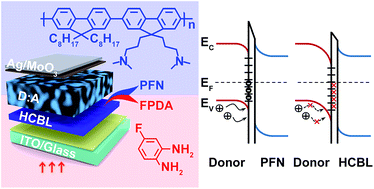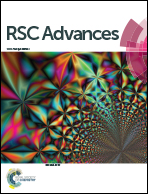Interface modification strategy based on a hybrid cathode buffer layer for promoting the performance of polymer solar cells†
Abstract
An interface modification strategy based on a hybrid cathode buffer layer (HCBL) is proposed and demonstrated through blending the interface modifier (4-fluoro-1,2-phenylenediamine, FPDA) with the host material (poly[(9,9-dioctyl-2,7-fluorene)-alt-(9,9-bis(3′-(N,N-dimethylamino)propyl)-2,7-fluorene)], PFN). By introducing FPDA, the carrier generation and extraction processes are regulated through the inhibition of interface exciton quenching, enhancement of hole blocking and passivation of electron transport, which are elaborated through steady-state and transient fluorescence spectra, frequency and bias related impedance analysis, and current density–voltage response. It is found that these three factors change simultaneously with the variation of FPDA content in HCBL, and the trade-off between the first two positive factors and the last one negative factor determines the final device performance. For instance, when the FPDA : PFN weight ratio is 0.16, the power conversion efficiency of the device increases to 6.24%, which is promoted by almost 20% in comparison with 5.22% of the pristine device. Thanks to the effectiveness, controllability and processability, this interface modification strategy offers a general method to provide an electrode buffer layer with multiple functions and a device with improved performance.


 Please wait while we load your content...
Please wait while we load your content...